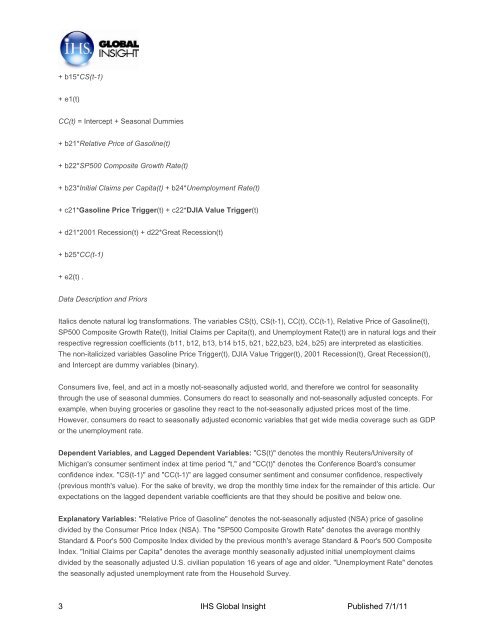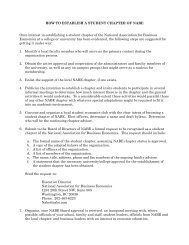An Econometric Analysis of Consumer Sentiment and ... - NABE
An Econometric Analysis of Consumer Sentiment and ... - NABE
An Econometric Analysis of Consumer Sentiment and ... - NABE
- No tags were found...
Create successful ePaper yourself
Turn your PDF publications into a flip-book with our unique Google optimized e-Paper software.
+ b15*CS(t-1)+ e1(t)CC(t) = Intercept + Seasonal Dummies+ b21*Relative Price <strong>of</strong> Gasoline(t)+ b22*SP500 Composite Growth Rate(t)+ b23*Initial Claims per Capita(t) + b24*Unemployment Rate(t)+ c21*Gasoline Price Trigger(t) + c22*DJIA Value Trigger(t)+ d21*2001 Recession(t) + d22*Great Recession(t)+ b25*CC(t-1)+ e2(t) .Data Description <strong>and</strong> PriorsItalics denote natural log transformations. The variables CS(t), CS(t-1), CC(t), CC(t-1), Relative Price <strong>of</strong> Gasoline(t),SP500 Composite Growth Rate(t), Initial Claims per Capita(t), <strong>and</strong> Unemployment Rate(t) are in natural logs <strong>and</strong> theirrespective regression coefficients (b11, b12, b13, b14 b15, b21, b22,b23, b24, b25) are interpreted as elasticities.The non-italicized variables Gasoline Price Trigger(t), DJIA Value Trigger(t), 2001 Recession(t), Great Recession(t),<strong>and</strong> Intercept are dummy variables (binary).<strong>Consumer</strong>s live, feel, <strong>and</strong> act in a mostly not-seasonally adjusted world, <strong>and</strong> therefore we control for seasonalitythrough the use <strong>of</strong> seasonal dummies. <strong>Consumer</strong>s do react to seasonally <strong>and</strong> not-seasonally adjusted concepts. Forexample, when buying groceries or gasoline they react to the not-seasonally adjusted prices most <strong>of</strong> the time.However, consumers do react to seasonally adjusted economic variables that get wide media coverage such as GDPor the unemployment rate.Dependent Variables, <strong>and</strong> Lagged Dependent Variables: "CS(t)" denotes the monthly Reuters/University <strong>of</strong>Michigan's consumer sentiment index at time period "t," <strong>and</strong> "CC(t)" denotes the Conference Board's consumerconfidence index. "CS(t-1)" <strong>and</strong> "CC(t-1)" are lagged consumer sentiment <strong>and</strong> consumer confidence, respectively(previous month's value). For the sake <strong>of</strong> brevity, we drop the monthly time index for the remainder <strong>of</strong> this article. Ourexpectations on the lagged dependent variable coefficients are that they should be positive <strong>and</strong> below one.Explanatory Variables: "Relative Price <strong>of</strong> Gasoline" denotes the not-seasonally adjusted (NSA) price <strong>of</strong> gasolinedivided by the <strong>Consumer</strong> Price Index (NSA). The "SP500 Composite Growth Rate" denotes the average monthlySt<strong>and</strong>ard & Poor's 500 Composite Index divided by the previous month's average St<strong>and</strong>ard & Poor's 500 CompositeIndex. "Initial Claims per Capita" denotes the average monthly seasonally adjusted initial unemployment claimsdivided by the seasonally adjusted U.S. civilian population 16 years <strong>of</strong> age <strong>and</strong> older. "Unemployment Rate" denotesthe seasonally adjusted unemployment rate from the Household Survey.3 IHS Global Insight Published 7/1/11













